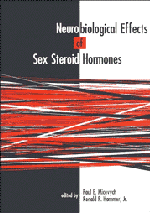Book contents
- Frontmatter
- Contents
- List of contributors
- Dedication
- Preface
- Acknowledgments
- Part I Sex steroid–responsive circuits regulating male and female reproductive behaviors
- Part II Sex steroid interactions with specific neurochemical circuits
- 5 Ovarian steroid interactions with hypothalamic oxytocin circuits involved in reproductive behavior
- 6 Sex steroid regulation of hypothalamic opioid function
- 7 Effects of sex steroids on the cholecystokinin circuit modulating reproductive behavior
- 8 Cholinergic regulation of female sexual behavior
- 9 Sex steroid regulation of tachykinin peptides in neuronal circuitry mediating reproductive functions
- 10 Dopaminergic influences on male rat sexual behavior
- 11 Studying neurotransmitter systems to understand the development and function of sex differences in the brain: the case of vasopressin
- Part III Cellular and molecular mechanisms regulated by sex steroids
- Index
6 - Sex steroid regulation of hypothalamic opioid function
Published online by Cambridge University Press: 15 October 2009
- Frontmatter
- Contents
- List of contributors
- Dedication
- Preface
- Acknowledgments
- Part I Sex steroid–responsive circuits regulating male and female reproductive behaviors
- Part II Sex steroid interactions with specific neurochemical circuits
- 5 Ovarian steroid interactions with hypothalamic oxytocin circuits involved in reproductive behavior
- 6 Sex steroid regulation of hypothalamic opioid function
- 7 Effects of sex steroids on the cholecystokinin circuit modulating reproductive behavior
- 8 Cholinergic regulation of female sexual behavior
- 9 Sex steroid regulation of tachykinin peptides in neuronal circuitry mediating reproductive functions
- 10 Dopaminergic influences on male rat sexual behavior
- 11 Studying neurotransmitter systems to understand the development and function of sex differences in the brain: the case of vasopressin
- Part III Cellular and molecular mechanisms regulated by sex steroids
- Index
Summary
The discovery that the hypothalamus is responsible for controlling both reproductive hormones and behavior suggested various mechanisms by which hormonal and behavioral cycles are inexorably linked, and even co-regulated. While our knowledge about this process has grown dramatically, our understanding of the essential control circuits that operate during normal reproduction, or fail in abnormal functioning, is still limited. Various neurotransmitter candidates have been proposed as essential elements of the systems that regulate reproduction. However, few are involved in so many aspects of reproduction as are the opioid peptides, which play a critical or supporting role in (a) controlling hormonal cycling in females (Akabori and Barraclough 1986; Kalra 1985; Wiesner et al. 1984), (b) regulating reproductive behavior in males (Hughes et al. 1988; Matuszewich and Dornan 1992; Myers and Baum 1979) and females (Pfaus and Pfaff 1992; Sirinathsinghji 1986; Wiesner and Moss 1986a), and even (c) modulating mesolimbic dopamine release mediated by reinforcing sexually relevant olfactory stimuli (Mitchell and Gratton 1991).
Gonadal steroid regulation of hypothalamic opioids represents an important feedback system by which to control reproduction. Hypothalamic (opioid) circuits regulate hormonal releasing hormones that control pituitary secretion. This regulation in turn affects gonadal steroid hormones, which act centrally to alter opioid function and facilitate reproductive behavior. Since such feedback is vitally important for the regulation of hormonal and behavioral events during the estrous cycle, most of this discussion will be limited to opioid action in females. Many of the experiments that we will describe utilized models of hormone manipulation to investigate natural regulation of hypothalamic opioid systems in animals, primarily rodents.
- Type
- Chapter
- Information
- Neurobiological Effects of Sex Steroid Hormones , pp. 143 - 159Publisher: Cambridge University PressPrint publication year: 1995
- 10
- Cited by



